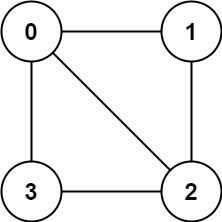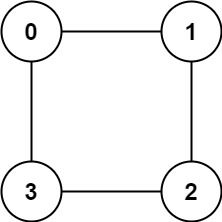There is an undirected graph with n nodes, where each node is numbered between 0 and n - 1. You are given a 2D array graph, where graph[u] is an array of nodes that node u is adjacent to. More formally, for each v in graph[u], there is an undirected edge between node u and node v. The graph has the following properties:
- There are no self-edges (
graph[u]does not containu). - There are no parallel edges (
graph[u]does not contain duplicate values). - If
vis ingraph[u], thenuis ingraph[v](the graph is undirected). - The graph may not be connected, meaning there may be two nodes
uandvsuch that there is no path between them.
A graph is bipartite if the nodes can be partitioned into two independent sets A and B such that every edge in the graph connects a node in set A and a node in set B.
Return true if and only if it is bipartite.
Example 1:
Input: graph = [[1,2,3],[0,2],[0,1,3],[0,2]] Output: false Explanation: There is no way to partition the nodes into two independent sets such that every edge connects a node in one and a node in the other.
Example 2:
Input: graph = [[1,3],[0,2],[1,3],[0,2]]
Output: true
Explanation: We can partition the nodes into two sets: {0, 2} and {1, 3}.
Constraints:
graph.length == n1 <= n <= 1000 <= graph[u].length < n0 <= graph[u][i] <= n - 1graph[u]does not containu.- All the values of
graph[u]are unique. - If
graph[u]containsv, thengraph[v]containsu.
class Solution:
def isBipartite(self, graph: List[List[int]]) -> bool:
def find(x):
if p[x] != x:
p[x] = find(p[x])
return p[x]
n = len(graph)
p = list(range(n))
for u, g in enumerate(graph):
for v in g:
if find(u) == find(v):
return False
p[find(v)] = find(g[0])
return Trueclass Solution {
private int[] p;
public boolean isBipartite(int[][] graph) {
int n = graph.length;
p = new int[n];
for (int i = 0; i < n; ++i) {
p[i] = i;
}
for (int u = 0; u < n; ++u) {
int[] g = graph[u];
for (int v : g) {
if (find(u) == find(v)) {
return false;
}
p[find(v)] = find(g[0]);
}
}
return true;
}
private int find(int x) {
if (p[x] != x) {
p[x] = find(p[x]);
}
return p[x];
}
}function isBipartite(graph: number[][]): boolean {
const n = graph.length;
let valid = true;
let colors = new Array(n).fill(0);
// 0 未遍历, 1 红色标记, 2 绿色标记
function dfs(idx: number, color: number, graph: number[][]) {
colors[idx] = color;
const nextColor = color == 1 ? 2 : 1;
for (let j of graph[idx]) {
if (!colors[j]) {
dfs(j, nextColor, graph);
if (!valid) return;
} else if (colors[j] != nextColor) {
valid = false;
return;
}
}
}
for (let i = 0; i < n && valid; i++) {
if (!colors[i]) {
dfs(i, 1, graph);
}
}
return valid;
}class Solution {
public:
vector<int> p;
bool isBipartite(vector<vector<int>>& graph) {
int n = graph.size();
p.resize(n);
for (int i = 0; i < n; ++i) p[i] = i;
for (int u = 0; u < n; ++u)
{
auto& g = graph[u];
for (int v : g)
{
if (find(u) == find(v)) return 0;
p[find(v)] = find(g[0]);
}
}
return 1;
}
int find(int x) {
if (p[x] != x) p[x] = find(p[x]);
return p[x];
}
};func isBipartite(graph [][]int) bool {
n := len(graph)
p := make([]int, n)
for i := range p {
p[i] = i
}
var find func(x int) int
find = func(x int) int {
if p[x] != x {
p[x] = find(p[x])
}
return p[x]
}
for u, g := range graph {
for _, v := range g {
if find(u) == find(v) {
return false
}
p[find(v)] = find(g[0])
}
}
return true
}function isBipartite(graph: number[][]): boolean {
const n = graph.length;
let valid = true;
let colors = new Array(n).fill(0);
function dfs(idx: number, color: number, graph: number[][]) {
colors[idx] = color;
const nextColor = color == 1 ? 2 : 1;
for (let j of graph[idx]) {
if (!colors[j]) {
dfs(j, nextColor, graph);
if (!valid) return;
} else if (colors[j] != nextColor) {
valid = false;
return;
}
}
}
for (let i = 0; i < n && valid; i++) {
if (!colors[i]) {
dfs(i, 1, graph);
}
}
return valid;
}

